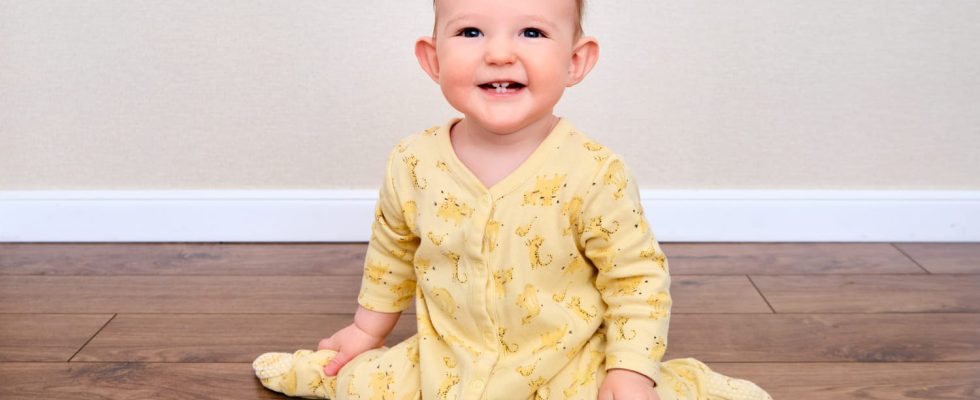Babies may have protruding-looking ears. Generally, this is not due to a malformation. However, in some cases, operations may be considered. Dr. Arnault Pfersdorff tells us more.
Parents are often worried when they see babies pulling on their ears, or when they seem to be sticking out as they grow. In principle, health professionals speak of protruding ears only from the age of 6 months. Generally, this detachment is not due to a malformation, and it can diminish naturally over time. How do you know if your baby really has protruding ears? At what age can a child have their ears fixed? In what cases are a baby’s ears operated and how? Answers with pediatrician Arnault Pfersdorff.
Why does baby have protruding ears?
“Protruding ears are often related to too much cartilage production”, explains Arnault Pfersdorff. A malposition or unusual development of the ears that is often hereditary. “But in general, having protruding ears is not considered a malformation unless the ear is for example too small, atrophied or its relief is badly finished”he reassures.
The premature baby may also have protruding-looking earsbecause they are not yet completely finished. “His cartilage is not complete and he may have bent ears or asymmetry”. Likewise among the twin babiesdetails the pediatrician: “There may have been a malposition in the mother’s belly, favoring a less well hemmed or toned ear on one side of the baby”. Indeed, the baby can have only one of the protruding ears, besides the surgeons when they intervene sometimes carry out unilateral autoplasties.
At what age does protruding ears occur?
The prominence of the baby’s ears can appear later. “It is not necessarily visible from birthbecause the baby does not yet have fat and the cartilage of the ears is not yet fully developed, we can thus notice a real detachment of the ears only after 6 months, or during the first year”. And, it can become more meaningful over time.
At the premature babies and babies resulting from a twin pregnancy whose ears are folded or appear protruding, these will be more noticeable when he sleeps with his head on the side. However, reassures the pediatrician: “it should get better over time since the cartilage will develop”. As you grow, the facial mass – the ears, the cartilage, the neck – and its fat content will develop and it is possible that the appearance of protruding ears decreases, whether less conspicuous. Hair growth can also fade it.
“You can notice a real detachment of the ears only after 6 months, or during the first year.”
If your baby’s ears don’t stick out, they won’t stick out afterwards, reassures the pediatrician. The position of his ear while he sleeps or the way the bonnet is put on cannot cause detachment. And even for babies with protruding ears, it will not be accentuated, “headbands and other band-aids aren’t much use”.
In which cases should baby’s ears be glued back?
“If the baby is doing well, sucking well and gaining weight, having protruding ears is not at all a sign of concern and it does not require any examination”, reassures Arnault Pfersdorff. On the other hand, if we feel that the child is in pain, withdraws into himself, is aggressive or no longer wants to go to school, we try to find out what is going on by talking to him. In consultation, the doctor also takes the opportunity to ask the child if all is well at school. Then, we discuss with the pediatrician before considering an operation. In this case, both parents must agree to the intervention.
What are the operations to glue baby’s ears?
Of the operations and cosmetic surgery techniques can be made to glue a child’s ears back together.
Otoplasty
On the operation side, the surgeon generally proceeds to a otoplasty, which is a surgical procedure performed under general anesthesia to reshape the auricle of the ear. Note that for this type of operation, the Primary Health Insurance Fund can bear part of the cost of the operation. For this, it is necessary to make an estimate with a health professional.
Implants
Another option: implants. This new cosmetic surgical technique can be invasive and is performed under local anesthesia. The implant is inserted under the skin at the level of the helix and can help the ear to reposition itself. “The type of intervention proposed will depend on the surgeon but also on the volume, the type of detachment and the shape of the ear”says the pediatrician.
Osteopathy
Osteopathy, which is a manual therapeutic technique, can help rebalance an asymmetrical ear in children. “Osteopathy may have a role if there is muscle asymmetry in muscle tone”, observes Doctor Pfersdorff. A transient physical alteration leading to greater muscle tone on one side can be observed in a baby born via a suction cup, forceps, by caesarean section or during a twin pregnancy, if it was not well positioned. As a result, an ear will be more prominent and this can lead to asymmetry. Osteopathy will then be able to contribute to rebalancing the muscular tone of the ear.
At what age can a child have their ears fixed?
We usually wait to operate until the child is at least 6 years old.unless the detachment is really important and we know that the child will suffer from it later. “It is moreover from CP that the mockery of comrades can begin. That said, the child is not necessarily going to talk about it himself either because he does not realize it yet or because he will be ashamed. It is the role of the parents but also of the pediatrician to ensure that the child is well in his sneakers “explains Dr. Pfersdorff.
Thanks to pediatrician Arnault Pfersdorff, author of the book “Your child from 0 to 16 years old” published by Hatier.
